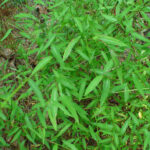Non-native Invasive Plants
When non-native plants become established, they can be invasive – overtaking native plants and threatening the insects and wildlife that depend on the native plants for survival. That’s why it’s so important to know the plants that are on your land and to take steps to eradicate those that don’t belong. These publications will help you identify non-native invasive plants on your Tree Farm.
- Non-native Invasive Plants of Southern Forests: A Field Guide for Identification and Control (USDA)
- Invasive Plants in North Carolina (N.C. Forest Service)
- Regional Plant Lists and Species Fact Sheets (North Carolina Invasive Plant Council)
- Mistaken Identity? Invasive Plants and Their Native Look-Alikes (Delaware Department of Agriculture)
Learn more about some of the common non-native invasive plants that threaten the health of North Carolina’s forests at the links below.
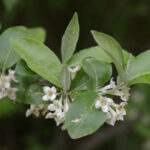 |
Autumn Olive (Elaeagnus umbellata)Autumn olive, introduced to the United States in the 1800s, was once recommended for use as an ornamental plant, a windbreak, erosion control, wildlife habitat and forest restoration. It now threatens native species by out-competing them and interfering with natural nutrient cycling and plant succession. |
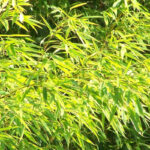 |
Golden Bamboo (Phyllostachys aurea)Native to Southeast China, golden bamboo reaches a maximum height of 30-40 feet, towering over most other grasses and forming a dense bamboo forest. Homeowners often use golden bamboo as a visual screen or noise barrier in their yards, but it can easily escape to nearby areas, using an extensive network of underground stems to grow new shoots and form new plants. |
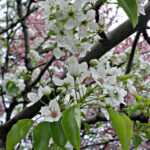 |
Callery/’Bradford’ Pear (Pyrus calleryana)
|
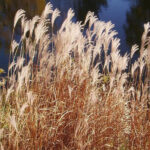 |
Chinese Silvergrass (Miscanthus sinensis)Chinese silvergrass was introduced to the United States about a century ago as an ornamental and is still widely sold for this purpose. It is an aggressive competitor with native species and a wildland fire hazard because of its large amount of dried biomass in the fall and winter. |
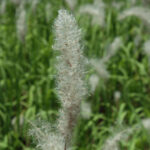 |
Cogongrass (Imperata cylindrica)Cogongrass was introduced to the United States unintentionally as packing material from Japan and then intentionally years later as a trial for forage. Cogongrass, one of the 10 worst weeds in the world, is well established in several southeastern states where it affects pine productivity and survival, wildlife habitat, recreation, native plants, fire behavior and site management costs. |
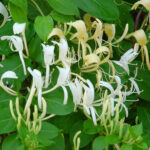 |
Japanese Honeysuckle (Lonicera japonica)Like many invasive plants, Japanese honeysuckle was introduced to the United States as a means of erosion control and as an ornamental. Although this plant has fragrant, showy flowers and can quickly cover unsightly areas, it is an aggressive, nonnative invasive plant that is difficult to control. |
|
|
Japanese Stiltgrass (Microstegium vimineum)Japanese stiltgrass was probably introduced to the United States in the early 1900s when it was used as packing material for Chinese porcelain. It is a particular threat to woodlands because it is adapted to low light conditions and is able to grow and produce seeds underneath a closed forest canopy. An individual plant can produce as many as 1,000 seeds that can remain viable for up to five years. |
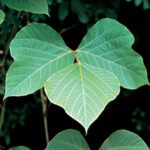 |
Kudzu (Pueraria montana)Kudzu is a perennial vine that can out-compete and kill everything from grasses to mature trees through crowding and shading. It can grow up to one foot a day, covering everything in its path and earning it the nickname “the vine that ate the South”. |
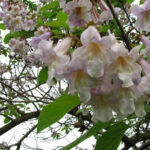 |
Mimosa (Albizia julibrissin)The mimosa tree was introduced to the United States as an ornamental tree in the 1700s. It escaped cultivation and is now growing along roadsides and streams, and in forests and clearings across the Southeast, competing with native species for light, water and nutrients. |
 |
Multiflora Rose (Rosa multiflora)Rosa multiflora, native to Japan, Korea and China, was introduced to the United States in the 1860s as rootstock for ornamental roses. It was later promoted for erosion control, living fences for containing livestock and for wildlife cover and food. It also was planted in highway medians as a crash barrier and to reduce headlight glare from oncoming vehicles. |
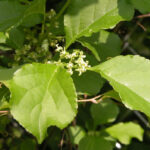 |
Oriental/Asiatic Bittersweet (Celastrus orbiculatus)Oriental bittersweet, a deciduous woody vine native to Asia, is found primarily in areas with full sun. It spreads by prolific vine growth and by seeds that birds and mammals spread. Oriental bittersweet is difficult to manage because cutting it stimulates the vine to re-sprout ten-fold and any broken-off piece of root will re-grow. |
 |
Princess Tree (Paulownia tomentosa)
|
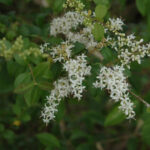 |
Privet (Ligustrum sinense)Chinese privet is a large shrub that was introduced in the 1950s to the United States from China as a garden plant. Today, it is widely invasive in the Southeast. Once it is present in a forest setting, it dominates the shrub layer and often becomes the only shrub underneath trees, especially in streamside areas. |
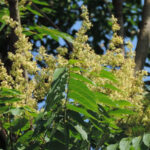 |
Tree-of-Heaven (Ailanthus altissima)Tree-of-heaven, which is native to Asia, was introduced to the United States as an ornamental. It is now one of the most widespread invasive trees in North Carolina. In forests, the tree can out-compete native plants, spreading and reproducing quickly. In addition, it is the preferred host of the spotted lanternfly, Lycorma delicatula, an invasive insect recently found in North Carolina. |
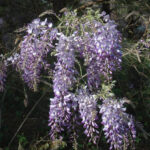 |
Wisteria (Wisteria sinensis and Wisteria floribunda)This deciduous, woody vine was brought to the United States as an ornamental and quickly became a favorite choice for garden arbors, gazebos, porches and walls. Most infestations of exotic wisteria in natural areas originally escaped from landscape plantings around old home sites. Once it escapes, exotic wisteria can harm surrounding native vegetation through shading and girdling. |

